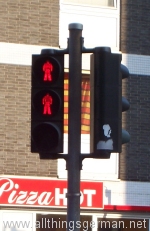One of the things that I’ve always wondered about in Germany, is why some pedestrian crossings – eg. in Nordrhein Westfalen – have two red men on them:

Pedestrian traffic lights in Cologne
I have two theories:
1. It reinforces the red light by having two. If one stops working, the other one should still light up.
2. It’s cheaper because the towns only need to buy one type of light and then use different filters on them, rather than buying 3-lamp and 2-lamp lights. Surely it must use more energy, though?
Does anyone know the answer?
